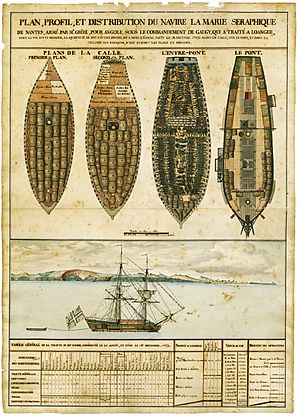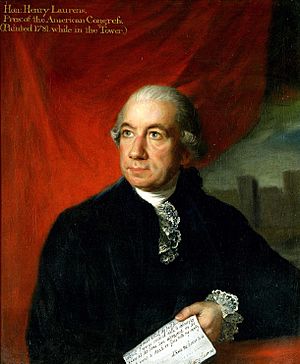John Knight (slave trader) facts for kids
John Knight (1708–1774) was an English slave trader. He organized at least 114 voyages that transported enslaved people between 1750 and 1775. During this time, he moved over 26,000 Africans to the Americas. Knight also traded enslaved Africans with Henry Laurens, an American politician and slave owner.
Contents
Who Was John Knight?
John Knight was a significant figure in the 18th-century slave trade. He was known for his large-scale operations from the port of Liverpool. His business involved buying and selling thousands of enslaved Africans.
Early Life and Beginnings
John Knight was born in Liverpool, England, in 1708. His father, also named John Knight, worked as a physician. Not much else is known about Knight's early life.
The Slave Trade Business
Knight was involved in at least 114 slave voyages between 1750 and 1775. He transported more than 26,000 Africans across the Atlantic Ocean. His ships sailed from the Port of Liverpool.
Voyages and Routes
Knight bought over 40% of the enslaved people from the Bight of Biafra. This area is off the West African coast, in the eastern part of the Gulf of Guinea. Today, this region in Nigeria is called the Bight of Bonny. The Bight of Biafra was a common trading spot for slave traders from Liverpool.
Ending a Monopoly
Knight was a member of the African Company of Merchants. Before 1750, the British Crown had a special right called a monopoly. This meant only one company, the Royal African Company, could trade enslaved people in West Africa. John Knight began his slave trading business in 1750, the same year this monopoly ended.
The Ship Fanny
John Knight owned a slave ship named the Fanny. In May 1755, the ship's Captain, William Jenkins, bought 171 Africans. Knight told Jenkins to sell these enslaved people for £30 each. If he could not get that price in the West Indies, he was instructed to sail to America to sell them there. The surviving enslaved people were eventually sold in Saint Kitts. Sadly, 20 people had died during the long voyage.
Letters with Henry Laurens
Knight often sold enslaved Africans to Henry Laurens. Laurens was an American slave trader, plantation owner, and political leader during the American Revolutionary War. He was one of the biggest slave traders in British North America. Laurens called Knight his friend. Some of their letters still exist today, showing details of their slave trading.
A Trader's Viewpoint
One letter from Laurens to Knight shows how slave traders viewed the people they bought. A ship called Emperor, led by Captain Charles Gwynn, left Africa with 390 enslaved people. During the journey, 120 of them died. Laurens wrote that he regretted losing the £2,000 these people could have been sold for. The ship belonged to Laurens and was headed for his hometown, Charleston, South Carolina.
Tempted Back to Trade
Laurens stopped being involved in the slave trade in 1762. However, Knight convinced him to return to it the next year. Laurens wrote to Knight that he "would rather not pursue that trade." But he agreed to sell the cargo for Knight. Laurens also wrote that the price of enslaved people was too low. This was because crops like rice and indigo were not selling well, meaning less labor was needed.
Challenges for Ships
In 1755, Laurens wrote to Knight and other Liverpool slave traders. He was worried about shipworms damaging their ships. He mentioned that Knight's ship, the Enterprise, was so damaged it had to be taken out of service. The shipworm responsible was a type of teredo. Laurens also wrote to Knight about a new law being discussed. This law would tax the slave trade and stop it for three years starting in 1766. Laurens voted against the law, but it still passed.
See Also



